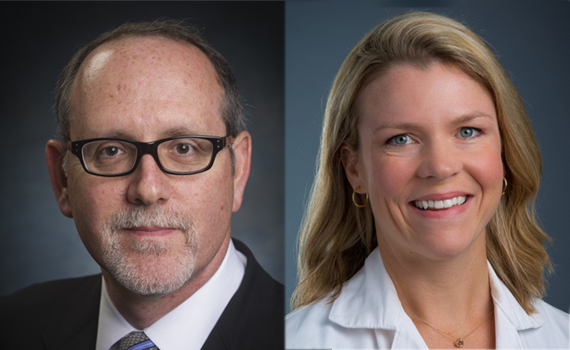
In observance of National Osteoporosis Awareness and Prevention Month, the Department of Medicine sat down with Ken Saag, M.D., MSc, Professor in the Division of Clinical Immunology and Rheumatology, and Amy Warriner, M.D., Professor in the Division of Endocrinology, Diabetes, and Metabolism, to learn more about osteoporosis prevention, risk, and treatment.
Q: What is osteoporosis? And who is at risk?
A: Osteoporosis is a bone disease. It develops when minerals such as calcium and phosphorous are depleted from the bone, making them weaker and susceptible to breaking (fracture). Osteoporosis is often called a “silent” disease because you typically do not have symptoms, and you may not even know you have osteoporosis until you break a bone.
Q: Why is Osteoporosis awareness important?
A: Once a patient breaks a bone, their chances of additional fractures significantly increase. When an individual fractures his or her hip bone, they face a 25% chance of fatality within a year of the incident. Awareness is critical to prevent these events.
Q: I’ve read that woman are at a higher risk for osteoporosis. Can you explain why this is?
A: Osteoporosis affects women and men of all races and ethnic groups. It can occur at any age, although the risk for developing the disease increases as you get older. Postmenopausal osteoporosis is the most prevalent form of osteoporosis. When women enter menopause, they experience a decline in estrogen production. Estrogen is crucial for maintaining bone health. When bone density decreases, women become more susceptible to fractures.
Q: How are men affected by this disease?
A: Experts typically begin evaluating men for osteoporosis at the age of 70. Prolonged steroid use, and prostate cancer increases men’s risk of this disease. Unlike many other diseases, osteoporosis in men has not been extensively studied. However, men with osteoporosis have a higher mortality rate after fractures, making it equally important for men to receive evaluation.
Q: What treatment options are available?
It’s important to know that bones are in a constant state of remodeling, forming, and breaking down. Our goal is to increase bone mineral density which decreases the patients’ risk of fractures. The most commonly used medication is bisphosphonates which block the breakdown of bones and reduces fracture risk by up to 50%. Medications like teriparatide and abaloparatide use biological communication to stimulate bone formation. There are new medications that are used to stimulate bone formation. These are typically reserved for people who have higher risk due to the potential side effects.
Q: What proactive measures can we take to prevent bone loss?
A: First, include calcium-rich foods like milk, yogurt, and cheese in your daily diet. Second, make sure you get enough Vitamin D through sunlight, nutrients, or supplements. Finally, stay active! Daily walks and weight bearing activities can improve bone density, balance, and posture.
In some cases, there can be a genetic component to osteoporosis. Getting a bone density test would help an individual identify their risk before any incident.
Q: How important is family support in managing this disease?
A: Fractures can be financially and emotionally straining for patients, but families as well. It is crucial to support patients in seeking evaluation and considering medical therapy to prevent future fractures. Also, conducting home assessments such as removing trip hazards, installing grab bars, and assisting with pets could help reduce the risk of falls for family members.
Q: Could you tell us more about the Osteoporosis Clinic at UAB?
A: The Osteoporosis Clinic is a multidisciplinary facility located in The Kirklin Clinic that provides state-of-the-art care. We have a dedicated team of physicians, dietitians, and physical therapists who work collaboratively to improve bone health. Our goal is to offer comprehensive care and personalized treatment plans to help patients effectively manage osteoporosis.
Q: Patients are the foundation of why you all do the work you do. Would you mind sharing your favorite patient stories?
A: A lady came to me after having a fracture in her back, and she was unable to do even light housekeeping because of the significant pain she was having. So we started a medication that is frequently associated with reduced pain following a back fracture, and two years later she comes back to me, she give me way too much credit, but she is able to travel and play with her grandkids and she has no daily pain in her back any more and more importantly has had no more fractures of her back or any other bones. – Amy Warriner
A: I think about one patient I saw right before the pandemic who had low bone density. We worked really hard to get her on medication because there were some challenges with insurance. She ended up having a couple of broken bones, but ultimately, we got her on a new medication, and she has really done remarkably well with that. She is now in her mid-to-late 90s, and she has had a 20% improvement in her bone density. We are really quite gratified by her improvement. -Ken Saag
To learn more about osteoporosis and the UAB Osteoporosis Prevention and Treatment Clinic you can visit UAB’s Tone Your Bones Website.